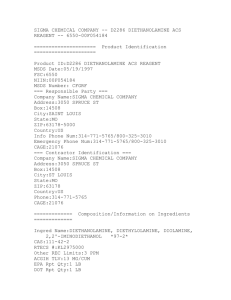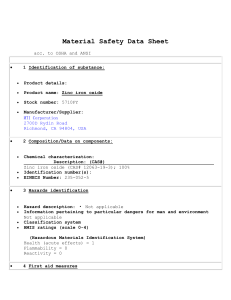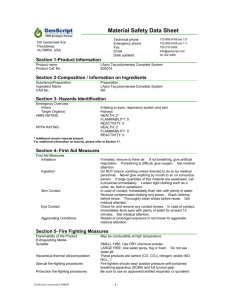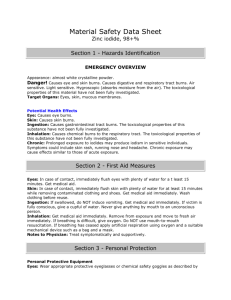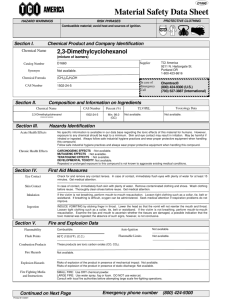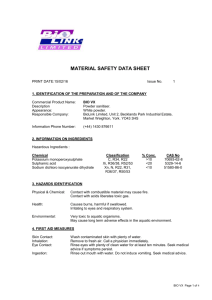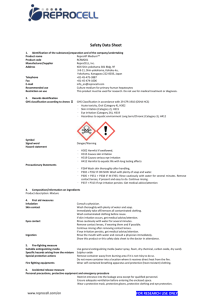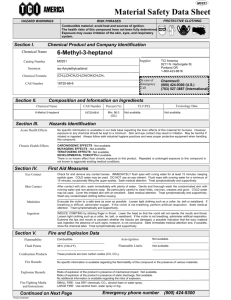Microsoft Word - CuSe - Stanford Advanced Materials
advertisement
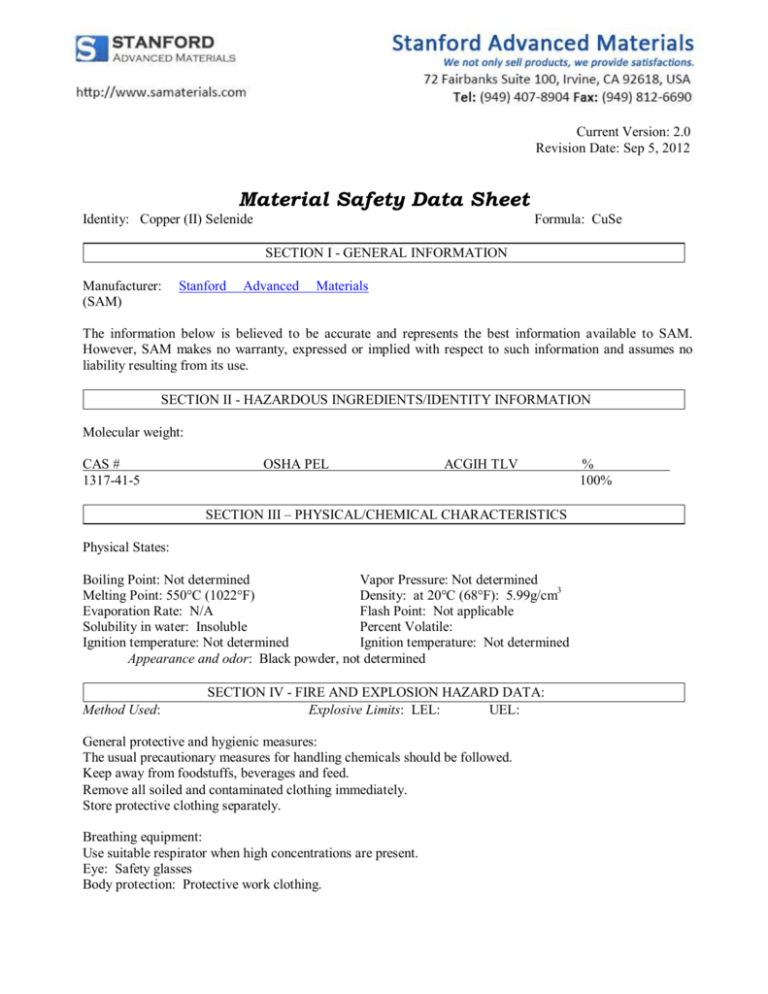
Current Version: 2.0 Revision Date: Sep 5, 2012 Material Safety Data Sheet Identity: Copper (II) Selenide Formula: CuSe SECTION I - GENERAL INFORMATION Manufacturer: (SAM) Stanford Advanced Materials The information below is believed to be accurate and represents the best information available to SAM. However, SAM makes no warranty, expressed or implied with respect to such information and assumes no liability resulting from its use. SECTION II - HAZARDOUS INGREDIENTS/IDENTITY INFORMATION Molecular weight: CAS # 1317-41-5 OSHA PEL ACGIH TLV SECTION III – PHYSICAL/CHEMICAL CHARACTERISTICS Physical States: Boiling Point: Not determined Vapor Pressure: Not determined Melting Point: 550°C (1022°F) Density: at 20°C (68°F): 5.99g/cm3 Evaporation Rate: N/A Flash Point: Not applicable Solubility in water: Insoluble Percent Volatile: Ignition temperature: Not determined Ignition temperature: Not determined Appearance and odor: Black powder, not determined Method Used: SECTION IV - FIRE AND EXPLOSION HAZARD DATA: Explosive Limits: LEL: UEL: General protective and hygienic measures: The usual precautionary measures for handling chemicals should be followed. Keep away from foodstuffs, beverages and feed. Remove all soiled and contaminated clothing immediately. Store protective clothing separately. Breathing equipment: Use suitable respirator when high concentrations are present. Eye: Safety glasses Body protection: Protective work clothing. % 100% Extinguishing Media: Special Fire Fighting Procedures: Firefighters must wear full face, self-contained breathing apparatus with full protective clothing to prevent contact with skin and eyes. Fumes from fire are hazardous. Isolate runoff to prevent environmental pollution. Unusual Fire and Explosion Hazards: When heated to decomposition, aluminum fluoride may emit toxic fumes of fluorine. May react violently when impacted in contact with sodium and potassium. May explode when heated with reducing agents. SECTION V – STABILITY AND REACTIVITY DATA Thermal decomposition/conditions to be avoided: Decomposition will not occur if used and stored according to specifications. Materials to be avoided: No information known. Dangerous reactions: No dangerous reactions known. Dangerous products of decomposition: Toxic metal oxide fume. Routes of entry: Inhalation? SECTION VI - TOXICOLOGICAL Skin? Eyes? Ingestion? Other? Health Hazards After Inhalation: Supply fresh air. If required, provide artificial respiration. Keep patient warm. Seek immediate medical advice. After Ingestion: Do not induce vomiting; immediately call for medical help. Seek immediate medical advice. After Skin: Immediately wash with water and soap and rinse thoroughly. See immediate medical advice. After Eye: Rinse opened eye for several minutes under running water. The consult a doctor. Acute toxicity: Skin: Irritant to skin and mucous membranes. Eye: Irritating effect. Sensitization: No sensitization effects known. Subacute to chronic toxicity: Selenium may cause amyotrophic lateral sclerosis, bronchial irritation, gastrointestinal distress, vasopharyngeal irritation, garlic odor on breath and sweat, metallic taste, pallor, irritability, excessive fatigue, loss of fingernails and hair, pulmonary edema, anemia and weight loss. Copper compounds may be irritating to the skin, eyes and respiratory tract. They may cause metal fume fever, hemolysis of the red blood cells cause vomiting, gastric pain, dizziness, anemia, cramps, convulsions, shock, coma and death. Additional toxicological information: To the best of our knowledge the acute and chronic toxicity of this substance is not fully known. EPA-D: Not classifiable as a human carcinogenicity: inadequate human and animal evidence of carcinogenicity or no data are available. NTP-3: Not classified as to carcinogenicity to humans. NTP-2: Reasonably anticipated to be a carcinogen: limited evidence from studies in humans or sufficient evidence from studies in experimental animals. Target Organ : N/A Ecological Information: Ecotoxical Effects: Remark: Very toxic for fish General Notes: Also poisonous for fish and plankton in water bodies. Do not allow material to be released to the environment without proper government permits. Very toxic for aquatic organisms. SECTION VII - PRECAUTIONS FOR SAFE HANDLING AND USE Storage: Requirements to be met by storerooms and receptacles: No special requirements. Information about storage in one common storage facility: No information known. Further information about storage conditions: Keep container tightly sealed. Store in cool. Dry conditions in well sealed containers. General protective and hygienic measures: Wear appropriate respiratory and protective equipment specified in section VIII-Control Measures. Isolate spill area, provide ventilation. Vacuum up spill using a high efficiency particulate absolute (HEPA) air filter and place in a closed container for proper disposal. Take care not to raise dust. Waste disposal method: Consult state, local or national regulations to ensure proper disposal. SECTION VIII - CONTROL MEASURES Protective Equipment Summary (Hazard Label Information): General protective and hygienic measures: The usual precautionary measures for handling chemicals should be followed. Keep away from foodstuffs, beverages and feed. Wash hands before breaks and at the end of work. Store protective clothing separately. Ventilation: Local Exhaust: To maintain concentration at low exposure levels. Mechanical (General): Recommended. Work/Hygienic/Maintenance Practices: Implement engineering and work practice controls to reduce and maintain concentration of exposure at low levels. Use good housekeeping and sanitation practices. Do not use tobacco or food in work area. Wash thoroughly before eating or smoking. Do not blow dust off clothing or skin with compressed air. Please be advised that N/A can either mean Not Applicable or No Data Has Been Established
